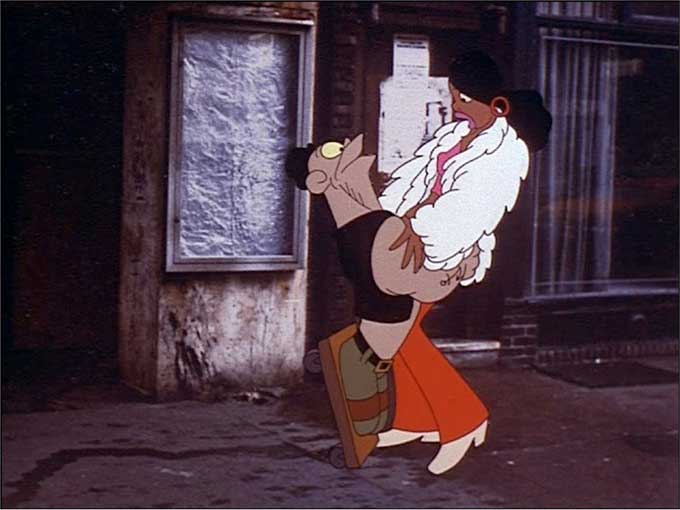The making of first hand-drawn VR cartoon

Even after a 25-year animation career, I can still remember the exact moment that I decided to become a professional animator: It was at an all-night movie marathon of Ralph Bakshi films. While watching Bakshi's Heavy Traffic (his 2nd feature release, but his first true auteur film) I was thunderstruck by its gritty honesty. The film served up top-quality character animation supporting a fiercely street-level aesthetic. To an impressionable teenaged animation fan raised solely on a diet of classic Disney features, this film was a revelation. Here were characters as richly textured as any of the street smart hustlers inhabiting the stories of Taxi Driver or Midnight Cowboy. I was elated! I now had a vision that it was possible to create "underground" animation in the vein of R. Crumb and so many of my underground comix heroes. I decided that night to move to L.A. and fashion a career in the animation business.
I did eventually move to Hollywood, where I got trained in classic animation techniques by Disney old-timers. I used those precious lessons to great success in the era of burgeoning digital animation in the 1990s and beyond. I was there the FIRST time VR stuttered to life in the mid 90s, only to have its plug pulled for lack of technical viability. Fast-forward past 24k-baud modems, the first PDAs, internet 1.0, handheld gaming systems, theme park rides -- I have created content for all of them. But I have never been as creatively (or technically) challenged as when I set about trying to create the first completely hand-drawn VR cartoon. It immediately took me back to that midnight theater in Pennsylvania where I got my first jolt of creative inspiration. I was determined to reinvent myself (again) in the medium of 360-degree 2D stereoscopic VR animation (say THAT 10 tens as fast as you can!).
This series tells the story of how I put together a crack team of animation and video professionals with no previous VR production experience and how, together, we figured out a successful path for pushing hand-drawn animation into a whole new world.
On a sleepy Sunday morning about 18 months ago, I was surprised to discover that a flat, unassembled Google "Cardboard" viewer had arrived with my New York Times. Watching the Times' VR content through the Cardboard viewer transported me out of my kitchen and deep into the full immersion world of 360 video. In a flash I saw my phone in a wholly different light. It was now able to be my window into an alternative cartoon world which I could manufacture and, more importantly, inhabit. It stirred in me those old feelings of awestruck inspiration.
The first thing I did the next day was to call up one of my favorite clients: TED Ed. I had been directing animated shorts for this pioneering group of online educators for the previous three years. I hoped to convey to my Executive Producer that the timing was right for TED Ed to create a pioneering short in 360 animated video for the Cardboard platform. I was hoping that they'd trust me enough to forgive any initial stumbles as we collectively felt our way through the inky darkness that is inherent in any new medium. My pitch was well-rehearsed and the idea got approved quickly. So now I was presented with my first great challenge: Having sold the concept to my client, how exactly should I go about actually producing the piece? I mean literally-which combination of off-the-shelf software programs to use and how many team members would it require?
While I was pondering these tech hurdles, TED Ed was asking me for ideas about which teaching topic should be the short's main concern. Luckily I had some ideas here. It was my impression that, because I was going to be drawing every pixel on the screen, I didn't want to have the subject matter include vast cityscapes or sprawling vistas (I came to do an about-face on this thinking later). I came up with three possible environments from which to cull a topic: immersed in the ocean, inside the body, or inside a prehistoric cave. For each of these topics I was thinking that the environmental "walls" would necessarily be abstract, amorphous, and still constrict the subject matter. I felt secure that if I gave myself the parameters of a singular closed environment, I'd be able to create a world that made sense in 360-degrees. To my delight TED Ed liked my favorite idea the best and we decided to pursue the history of Stone Age cave painting. The irony was not lost on me that we'd be teaching about mankind's oldest known attempts at creative expression while utilizing perhaps the brand-newest method of presenting this information: virtual reality.
Below is the first concept painting that I presented to TED Ed to help them visualize the world inside the cave. On the strength of this flat panoramic painting, they "green-lit" the project

Now the real work began in earnest. I needed to find a production team that was doing something (even distantly) related to hand-drawn animation in VR. I felt that if that team already had some basic VR experience, then adjusting the workflow to accommodate 2D animation wouldn't be such a big deal. Just swap assets, right? In reality this turned out to be an extremely difficult problem to solve. It took multiple tries with multiple creative teams until we got even close to cracking that nut.
In the next installment I'll reveal all of the fits and starts the production ran into as we attempted to push traditional animation into a wholly new and different medium. Here's a hint: We were approaching the problem completely ass-backwards!
Stay tuned to our next installment: "The Frustrating Truth About Being an 'Early Adopter'".